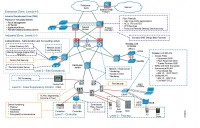he real-time Ethernet port multiplier allows the connection of eight independent Ethernet networks. The CU2508 is connected to the PC via a gigabit uplink. The PC offers high-performance data transfer to the multiplier, which allocates the data to the relevant 100BASE-TX port based on an analysis of a frame prefix and sends them time-controlled with µs precision. Received frames are also allocated a prefix including a timestamp and sent to the PC. With the support of a driver, users have eight independent ports with full real-time characteristics available. The CU2508 is used in applications in which several Ethernet ports are required that need to be realised outside the PC. TwinCAT supports the CU2508 and makes further network ports at the PC unnecessary. For extremely high demands, an EtherCAT installation can, for example, be distributed or expanded to up to eight lines in order to multiply the performance. The distributed clocks of the EtherCAT lines are synchronised. An EtherCAT cable redundancy can also be realised using two ports of the CU2508.
For further details please click 'Real-time Ethernet port multiplier'
Buty dziecięce
 The RadioLinx Industrial Frequency Hopping 900 MHz Ethernet provides powerful and secure wireless Ethernet communications and is well suited for demanding, long-range (up to 30+ miles) SCADA and other Ethernet applications in tough environments. Operating in the license-free 900 MHz band, the RadioLinx Industrial Frequency Hopping 900 MHz Ethernet penetrates foliage and walls / ceilings better than higher frequency radios. The RLX-IFH9E is user configurable as a master, repeater and remote radio and employs the 128 bit AES encryption algorithm approved by the United States government for top secret information.
The RadioLinx Industrial Frequency Hopping 900 MHz Ethernet provides powerful and secure wireless Ethernet communications and is well suited for demanding, long-range (up to 30+ miles) SCADA and other Ethernet applications in tough environments. Operating in the license-free 900 MHz band, the RadioLinx Industrial Frequency Hopping 900 MHz Ethernet penetrates foliage and walls / ceilings better than higher frequency radios. The RLX-IFH9E is user configurable as a master, repeater and remote radio and employs the 128 bit AES encryption algorithm approved by the United States government for top secret information. Beyond improving quality, uptime, and productivity, functional safety is often a requirement in applications leveraging mobile robotics. While local proximity sensors, E-Stops, safety zones, and safety curtains are often used in AMR applications, a SIL 2 or SIL 3 safety rating for the AMR system as a whole requires the use of a SIL 3-rated safety protocol like CIP Safety or PROFIsafe.
Beyond improving quality, uptime, and productivity, functional safety is often a requirement in applications leveraging mobile robotics. While local proximity sensors, E-Stops, safety zones, and safety curtains are often used in AMR applications, a SIL 2 or SIL 3 safety rating for the AMR system as a whole requires the use of a SIL 3-rated safety protocol like CIP Safety or PROFIsafe. Moore Industries: Designed specifically for demanding industrial applications the Net Concentrator System (NCS) proides a real-time signal gateway between between the factor floor and your control strategy. NCS can be used when you need when you need to network new and legacy network censors, instrument and final control elements. It is modular and can be programmed to various configurations.
Moore Industries: Designed specifically for demanding industrial applications the Net Concentrator System (NCS) proides a real-time signal gateway between between the factor floor and your control strategy. NCS can be used when you need when you need to network new and legacy network censors, instrument and final control elements. It is modular and can be programmed to various configurations. Many manufacturers segment business-system networks from plantwide networks by using an industrial demilitarized zone (IDMZ). But once segmented, how is data from industrial automation and control systems (IACS) securely shared across this buffer zone?
Many manufacturers segment business-system networks from plantwide networks by using an industrial demilitarized zone (IDMZ). But once segmented, how is data from industrial automation and control systems (IACS) securely shared across this buffer zone?